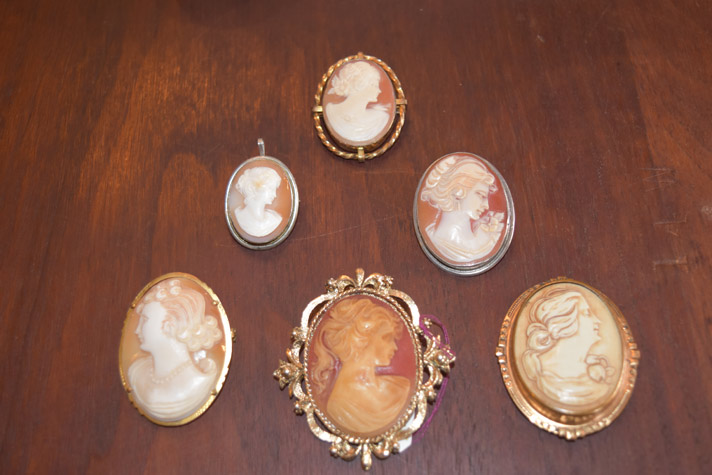Speaking of Antiquing – May 2017
Although some ignore the time-treasured brooch in favor of something trendier, the cameo has always been a fashion statement. (A brooch is defined as “an ornament fastened to clothing with a hinged pin and catch.) By “always,” I mean at least as far back as the Hellenistic period in the 3rd Century B.C. The ancient Greeks artistically carved gemstones that showed different colors in different layers, such as agate and sardonyx. The cameo was used largely as signet rings, earrings and objects d’art. The Romans used stones as well as shell and ivory and both cultures depicted mythological gods, goddesses, rulers, flowers, and portraits.
Napoleon and Josephine were intrigued with cameos. Josephine wore a cameo brooch every day and Napoleon commissioned artisans to create jewelry for men and women. The cameo became the symbol of his reign; even his crown was decorated with cameos. The cameo was incorporated into daily life. Shells and semi-precious stones were carved to make the cameo available to the common person.
Later in Victorian England, cameos were carved from metal, wood, shell, ivory, and precious stones. Wedgwood made cameos from Jasperware, and even clothing had cameo buttons carved from wood. Queen Victoria loved to wear highly-embellished cameos with diamonds and other precious stones; the cameo became a fashion statement and symbol of wealth and status.
The upper middle class and the wealthy obtained cameos on their “Grand Tours” through Italy. To wear the piece was to declare that they had been to Italy. Black and white cameos were popular at the time, made from the lava from Pompeii. By the end of the 19th Century, cameos were mass-produced.
In the 20th Century, cameos were made from Celluloid, Lucite and resins. Many shell cameos were still made by artisans depicting ancient themes, set in sterling silver as well as gold. Lesser-quality cameos were set in brass or copper. Earrings, pendants and rings were ever popular as brooches were falling from fashion.
The shells used in making the cameos were typically conch, mussel, cowry, and mollusk. Ivory cameos gained lovely patina over the years and were highly prized, but of course the use of ivory had to be curtailed.
If you inherited a lovely cameo, don’t let it sit in a box, bring it to light and enjoy the beauty of it.
If you are curious as to what material your cameo is made from, hold it up to the light. Most shell cameos will be translucent, resin or plastic will be dense. Natural stone will be cold to the touch. There are tests for ivory that require hot pins. If you need to clean a cameo, do not use chemicals; just use a dab of water and a soft bristle brush.
Cameos can be easily found in most Antique stores, online auctions and even pawn shops. At Pickety Place, we have a selection of shell cameos as well as some modern plastics and resin pieces.
Mother’s Day is approaching—surprise her with something she didn’t know she wanted.

 Margaret Barns is co-owner of Pickety Place Antiques & Collectibles located at 130 N. 4th Street in Jacksonville. LIKE them on
Margaret Barns is co-owner of Pickety Place Antiques & Collectibles located at 130 N. 4th Street in Jacksonville. LIKE them on